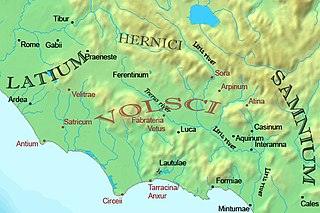Volsci

The Volsci ( was of Volscian descent.
Description by the ancient geographers
Pontine marshes
, which took their name from the plain.
Language
The Volsci spoke
In the Volscian territory lay the little town of Velitrae (modern
Conflict with ancient Rome
The Volsci were among the most dangerous enemies of ancient Rome, and frequently allied with the Aequi, whereas their neighbors, the Hernici, were allied with Rome after 486 BC.[7][4]
According to the semi-legendary history of early Rome, its seventh and last king, Lucius Tarquinius Superbus, was the first to go to war against the Volsci, commencing two centuries of conflict between the two states.[8]
Gaius Marcius Coriolanus, the legendary Roman warrior, earned his cognomen after capturing the Volscian town of Corioli in 493 BC. The reputed rise and fall of this Roman hero is chronicled in Plutarch's Parallel Lives, which served as the basis for the Shakespeare play, Coriolanus.[9]
However, if
Roman senate arranged for the purchase of grain from the Volsci to feed the lower classes of Rome.[10]
Prominent Volsci
- Camilla in Virgil's Aeneid, a Volscian Warrior Maiden (like the legendary Amazons).
- Attius Tullus Aufidius, leader of the Volsci during the Roman–Volscian wars.
Prominent Romans of Volscian ancestry
Roman Gentes of Volscian origin
References
- ^ "Volsci". The American Heritage Dictionary of the English Language (5th ed.). HarperCollins. Retrieved 31 May 2019.
- ^ "Volsci". Collins English Dictionary. HarperCollins. Retrieved 31 May 2019.
- ^ "Volsci". Merriam-Webster.com Dictionary. Retrieved 31 May 2019.
- ^ a b c One or more of the preceding sentences incorporates text from a publication now in the public domain: Conway, Robert Seymour (1911). "Volsci". In Chisholm, Hugh (ed.). Encyclopædia Britannica. Vol. 28 (11th ed.). Cambridge University Press. pp. 197–198.
- ^ Strabo. "Book 5 Chapter 3". Geography. Tufts University, Perseus Digital Library.
- ISBN 978-1-4443-9358-3.
- ^
Nathan Rosenstein; Robert Morstein-Marx (7 September 2011). A Companion to the Roman Republic. John Wiley & Sons. pp. 279–. ISBN 978-1-4443-5720-2.
- Ab urbe condita1.53
- ISBN 978-0-521-07529-9.
- Ab urbe condita2. 9
Further reading
- Coarelli, Filippo. "Roma, i Volsci e il Lazio antico". In: Crise et transformation des sociétés archaïques de l'Italie antique au Ve siècle av. JC. In: Actes de la table ronde de Rome (19-21 novembre 1987). Rome: École Française de Rome, 1990. pp. 135–154. (Publications de l'École française de Rome, 137) [www.persee.fr/doc/efr_0000-0000_1990_act_137_1_3901]
